Libya Fight Reaches Tripoli
After months of fits and starts, it appears anti-Gaddafi forces are on the verge of victory.
After months of fits and starts, it appears anti-Gaddafi forces are on the verge of victory.
Al Jazeera (“Libyan fighting reaches streets of Tripoli“):
Sustained automatic gunfire and a series of explosions rang out in Tripoli overnight as rebels launched efforts to permanantly free the Libyan capital from Muammar Gaddafi’s grasp, according to reports from witnesses and rebels.
Blasts and gunfire rocked the city after sunset on Saturday, and witnesses reported street protests and fighting in the eastern neighbourhoods of Souq al-Jomaa and Tajoura. Beginning at around 9pm local time, residents also took to the streets in the Fashloum, Fournaj, Sabah, Ghoud al-Shayal, Hanshir and Dahra areas, many of them emerging from mosques and chanting “God is great”.
Expatriate Libyans speaking to family members in the capital said their relatives described men going out to protest, some with weapons, while children and women were asked to stay home. Meanwhile, NATO aircraft reportedly carried out bombing raids after nightfall.
Government spokesman Moussa Ibrahim said rebels had tried to attack Tripoli but had been “dealt with”. Ibrahim appeared on state television in the early morning hours in Tripoli’s central Green Square, riding in a car and surrounded by tens of supporters. Gaddafi himself never appeared, though he released an audio message congratulating citizens for repelling an attack by “rats”. “Sure, there were some armed militants who escaped into some neighbourhoods and there were some scuffles,” Ibrahim said. “But we dealt with it within a half hour and it is now calm.”
[…]
Colonel Fadlallah Haroun, a military commander in Benghazi, said the battles marked the beginning of Operation Mermaid Dawn. Tripoli’s nickname in Libya is “Bride of the Sea,” or mermaid.
Haroun told the AP news agency that weapons were assembled and sent by tugboats to Tripoli on Friday night. “The fighters in Tripoli are rising up in two places at the moment – some are in the Tajoura neighbourhood and the other is near the Matiga airport,” he told Al-Jazeera.
The Guardian is live-blogging the progress of the rebel forces.
Al Jazeera a companion timeline piece discussing how we’ve reached this point:
February 17: The Day of Revolt. The first major protests and violent clashes in Libya actually began two days before this, on February 15, mostly in Benghazi. Hundreds gathered outside the police station, and a number of protesters were killed.
But February 17 was the official “day of revolt,” an effort tobring thousands of protesters into the streets. Major demonstrations were reported in Benghazi, Ajdabiya, Darnah and Zintan, among others; Gaddafi forces responded by firing live ammunition at the crowds. More than a dozen demonstrators were killed.
Gaddafi reportedly released dozens of prisoners from jail and paid them to fight against the protesters.
The “day of revolt” coincided with the fifth anniversary of a major anti-Gaddafi protest in Benghazi.
Protests continued to escalate after February 17, and there were widespread reports that Gaddafi had hired mercenaries to supplement his security forces and suppress the demonstrations.
February 20: Rebels take Benghazi. After several days of fighting, and hundreds of people killed, anti-Gaddafi fighters seized control of Libya’s second city.
Cities further east, including Baida and Tobruk, were already under rebel control at this point. Doctors at Benghazi’s ill-equipped hospitals said more than 300 people were killed in several days of fighting, which included numerous attacks on funeral processions.
The key event in the battle for Benghazi was the fall of the Katiba, the city’s well-stocked military garrison staffed by (among other units) the feared Khamis Brigade. Fighters armed with rifles and homemade bombs laid siege to the garrison for several days, and a reported suicide car bomber eventually blew a hole in the building’s gate, allowing the fighters inside.
Gaddafi would continue to launch sporadic attacks on Benghazi in the weeks to come, but would never regain control of the city.
March 10: Gaddafi bombs Brega; retakes Zawiyah, Bin Jawad. Further west, though, the early weeks of the war did not go well for the rebels.
After an initial advance, Gaddafi began pushing the rebels back. His military shelled Ras Lanuf, a key oil port in eastern Libya, and seized the nearby town of Brega; there was also fierce fighting in Ajdabiya, another stop on the road to Benghazi.
Residents in the “rebel capital” grew increasingly fearful of bombing raids from Gaddafi’s air force.
A small revolt in Zawiyah, 50km to the east of Tripoli, was quickly crushed by Gaddafi’s forces; that early defeat made many Libyans in the east reluctant to oppose the government.
Gaddafi delivered several memorable speeches on Libyan state TV in late February and early March. He oftenblamed the protests on foreign intervention, and threatened to hunt down the protesters – “alley to alley, house to house.”
The rebel losses in the east were a major reason for the push for a no-fly zone over Libya.
March 19: NATO starts bombing Libya. After a debate, the United Nations Security Council voted to impose a no-fly zone over Libya. Ten of the council’s 15 members voted “yes,” while five – Russia, China, India, Germany and Brazil – abstained.
The resolution called for international military action to protect civilians. It would be enforced primarily by NATO, with logistical support from several Arab countries, including Qatar and the United Arab Emirates.
French jets began bombing Libya just hours after the resolution was passed, with bombers from the United States, the United Kingdom and other countries joining shortly afterwards.
Rebel commanders would frequently complain about the pace of NATO airstrikes (they wanted more), and several of them missed their intended targets and killed rebel fighters instead. But the bombing campaign was undeniably a major reason why Gaddafi’s military advance halted in mid-March.
May 15: Gaddafi forces withdraw from Misrata. The seaside city of Misrata was besieged for months by Gaddafi forces; they surrounded it and frequently lobbed mortars downtown.
Hundreds of civilians and rebel fighters were killed, and thousands more wounded, during weeks of fighting in the city centre and near the port. Civilians reported appalling living conditions: scarce food and water, little to no electricity, and a severe shortage of medical supplies.
NATO planes began bombing the city in late April, targeting Gaddafi’s tanks and artillery. Rebels began their own counter=offensive on April 25, pushing slowly from the east, seizing the port area and working their way through the city.
A fierce battle on May 11 left the rebels with control of the airport, and four days later they declared the battle for Misrata over.
July 28: Major push in the Western Mountains. Rebel gains in the east slowed down after the Misrata campaign, but they began winning territory in western Libya, allowing them to surround Gaddafi in Tripoli.
The rebels began their push in early June, and for several weeks they reported steady gains, capturing scattered villages and seizing much-needed supplies from the Gaddafi troops stationed in the region.
Their advance was halted in early July at the town of Qawalish. It took several advances to seize the town; rebels had to retreat at one point because they ran out of ammunition.
By late July, the rebels were pushing down from the Nafusa Mountains to towns in the foothills, allowing them to control strategically-important roads linking Tripoli to Tunisia – Gaddafi’s main source of supplies.
Rebels would seize several other important towns, including Tiji and Bir al-Ghanam, after the start of Ramadan in August.
August 15: Rebels take Gharyan. The war’s final phase seemed to begin last week, when rebels reported taking control of Gharyan, a town about 80km south of Tripoli.
That victory allowed them to completely encircle the Gaddafi-controlled capital: All of the major highways leading out of Tripoli now pass through rebel-controlled areas.
Control of Gharyan, and the town of Zawiyah in the west, is not yet absolute; there are still reports of scattered shelling by Gaddafi’s artillery. But the Libyan leader has been unable to retake these towns, and with reports offighting on the streets of Tripoli, his grip on power is weaker than ever.
As I outlined a month ago in a piece for The Atlantic, the fight isn’t over once Gaddafi is ousted and it’s not clear that much planning has been done to prepare. Still, getting Phase III over with and Gaddafi out of power would be a welcome development.
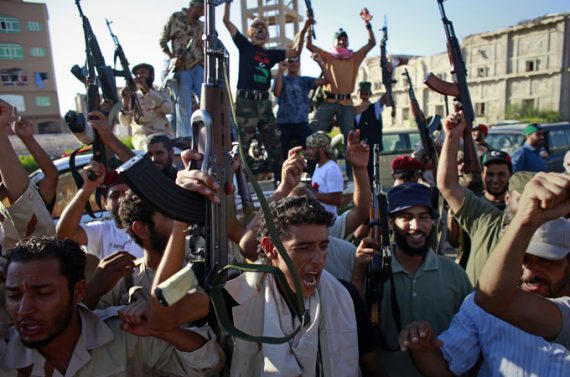

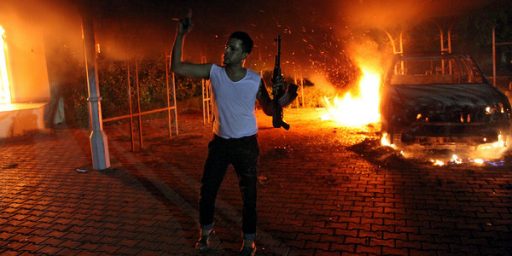
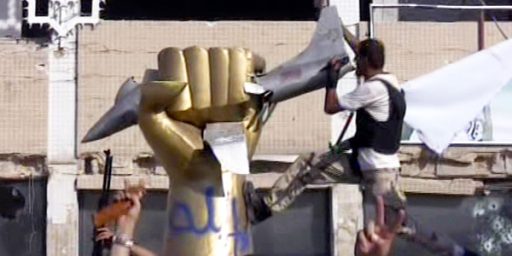
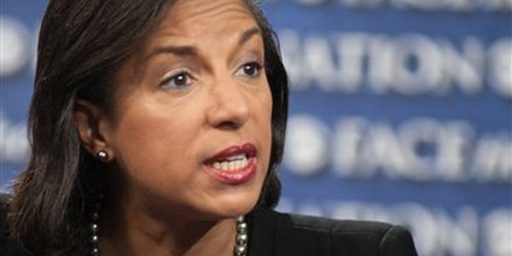
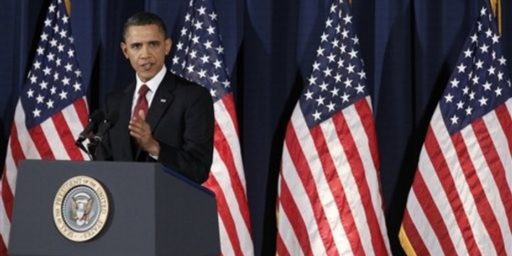
Seems like it was just weeks ago when people were crowing over the “stalemate” in Libya with a chorus of “I told you so’s”. Including yours truly. I would be happy to wrong again. But as you said James, “What is next?”
It’s been clear for months this would happen — so long as the rebels stayed united. So far so good.
The lack of western reporting on this has left a vacuum which has been filled by the politically-motivated to repeatedly declare stalemate or defeat. (That’s not a shot at you, Ozark.) It is of course very important to the non-neocon majority of the GOP to see Obama fail. And it’s important to the Left to see US interventionism fail.
My approach has been to focus on the map and the Al Jazeera position reports. In very brief it went like this:
1) Gaddafi moving on strongest rebel city, Bengahzi. Fail.
2) Gaddafi besieging Misurata. Fail.
3) Rebels taking Tunisian border posts.
4) Tripoli surrounded and cut off.
It’s the kind of “war” that when reduced to the one paragraph summary it will deserve in some future American history book will read as a quick, easy, bloodless (for us) toppling of a tin pot dictator in a not-very-important country. The rough equivalent of George HW BUsh’s takedown of Noriega.
The final casualty count is up to Gaddafi. Is he going to play HItler-In-The-Bunker? Or will he run off to exile and stay alive. It’s down to just how suicidal this guy feels over the next weeks.
NATO’s military role is almost over. (It’s urban street warfare now, and jets and drones can only do so much.) As of today the US body count is: zero. A brief Googling also turns up no NATO deaths.
So we have here an operation (whatever the wisdom of launching it) that was a display of amazingly effective diplomacy, followed in roughly six months by victory. We will have knocked off the man who ordered Lockerbie, strengthened NATO, and sent a very chilling message to tyrants around the world that we can get them and do it without spilling a drop of our own blood.
All in all a testament to the effectiveness of Mr. Obama.
I was opposed to the Lybia intervention from day one, because we have too many wars going on already, I worry that we will be bogged down in reconstruction for the next decade, but I would be happy to be wrong.
And, so far, it looks like President Obama is making me happy. Color me cautiously optimistic to be wrong.
Republicans having to eat crow would be icing on the cake.
@michael reynolds:
Michael, I was wrong and am happy to admit it. I was not heavily invested in the story and kept at best, only half an eye on it.
@Gustopher:
And I still feel as you do Gustopher.
@Gustopher:
See if you still think that’s icing when this ends up reempowering the warhawk wing of the party to start pushing for attacks on Iran.
That may happen, these folks just don’t seem to be happy unless we are blowing something up. The good news is that we are on the verge of cleaning up yet another of Bush’s messes – the post Iraq paper tiger effect. Bringing about regime change without (so far) any of the disasters that went along with the Iraq war is a powerful cautionary tale for governments in the middle east that are unfriendly to us – we can act decisively and effectively if necessary. My guess is that there will be a little more movement to middle ground by Iran and Syria.
Iraq wasn’t a mess until after the fall of Baghdad either. I wouldn’t be so quick to decide Libya has acheived non-messhood, especially since, like the Bush administration in Iraq, the current administration doesn’t seem to have a clear plan for what happens next. Just the same faith that if you knock out the stronman, democracy will spring up spontaneously.